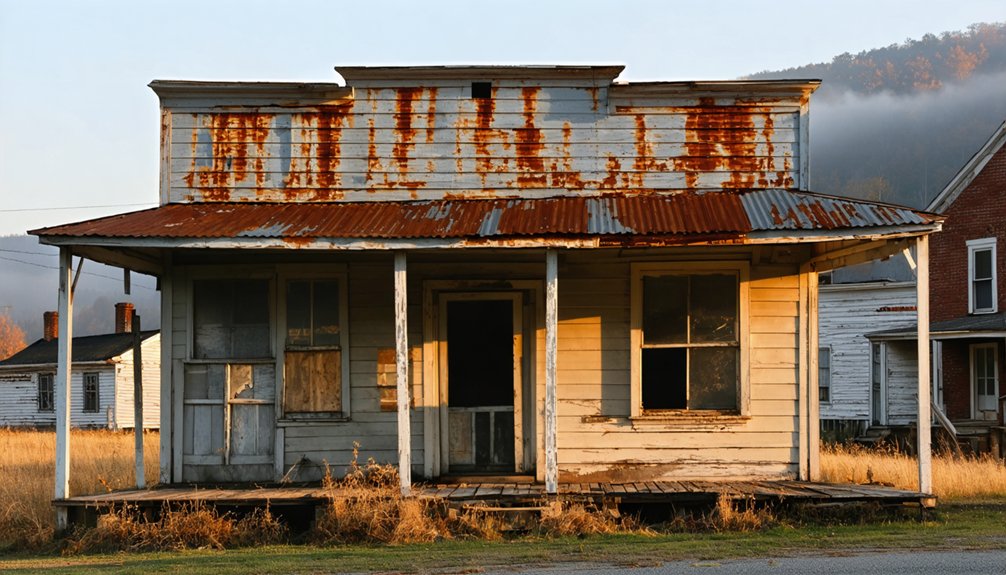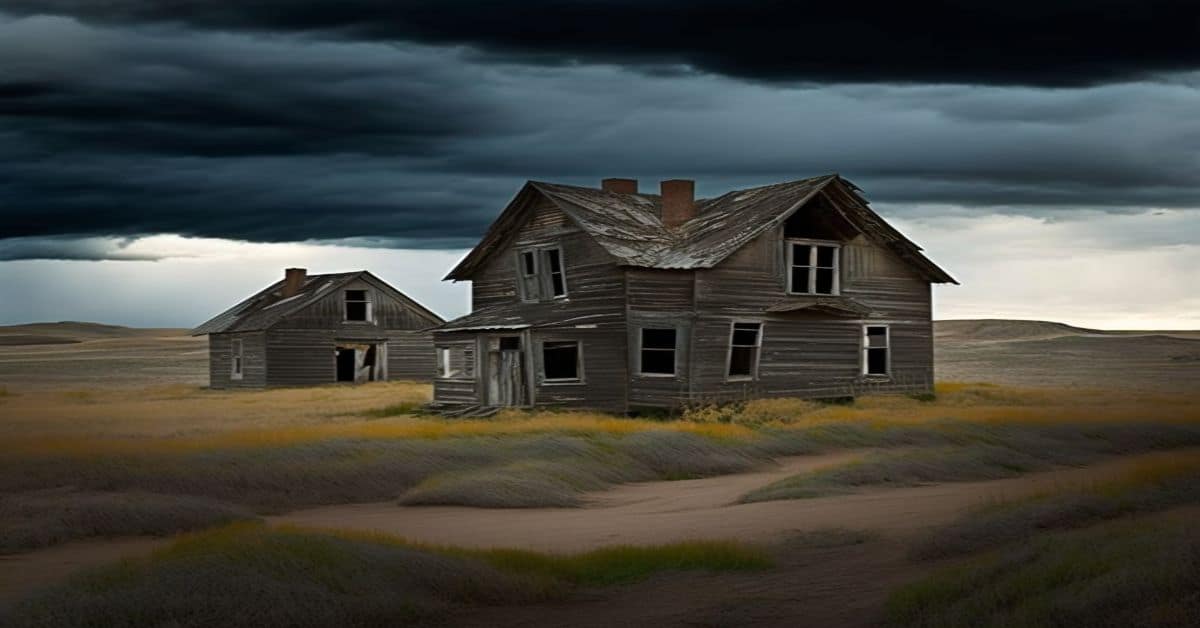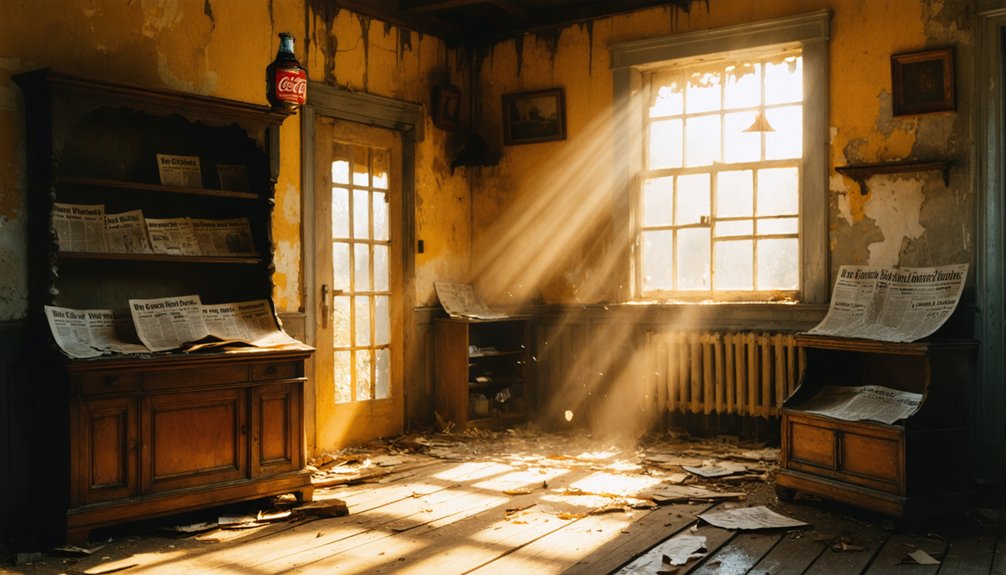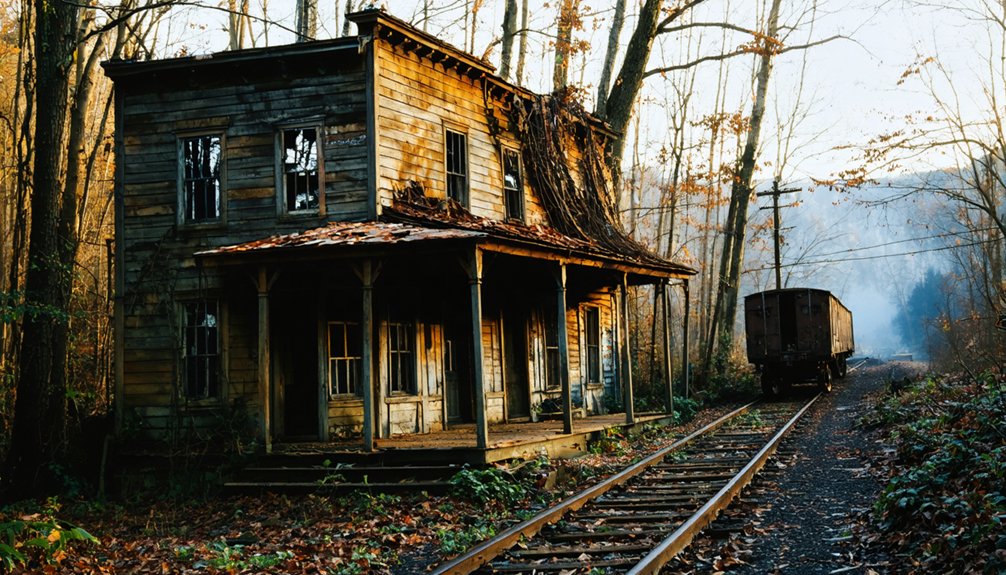You’ll find Barebone nestled in Kentucky’s rolling hills, where Daniel Boone’s Wilderness Road once carved through the wilderness. This former coal mining hub thrived in the early 1900s along Barebone Creek, featuring traditional log cabins, a one-room schoolhouse, and essential mining operations. After the mines closed in the 1960s, the town fell into decline, leaving behind weathered headstones, abandoned mine entrances, and stone foundations that whisper stories of its industrial past.
Key Takeaways
- Located near the Ohio River, Barebone was a thriving trade hub established in the mid-1700s by Native Americans and European settlers.
- The town’s economy centered on coal mining, lumber industries, and river trade until its decline began in the 1960s.
- Cultural heritage includes preserved log cabins, abandoned mines, stone bridges, and a historic cemetery with weathered headstones.
- Barebone Creek served as the town’s lifeline, supporting commerce and cultural exchange through flatboat and steamboat traffic.
- The ghost town’s demise was sealed by the 2012 coal industry collapse, leaving behind industrial ruins and a depleted population.
The Origins of Barebone Creek Settlement
While Native American groups including the Shawnee and Six Nations Iroquois had established settlements in the region by the mid-1700s, European exploration of what would become Barebone Creek didn’t begin until the late 17th century.
The settlement patterns of early Europeans were heavily influenced by native interactions, often leading to contested territories and abandoned outposts. You’ll find that European diseases hadn’t yet devastated the indigenous population when the first traders arrived in 1674, making the region a complex frontier of cultural exchange and conflict.
The establishment of permanent settlements accelerated after Daniel Boone cut the Wilderness Road, though many early attempts at colonization proved temporary. Similar to Elsewhere, Kentucky, numerous settlements vanished from maps and records over time.
Like other Kentucky settlements of the era, Barebone Creek’s location was likely chosen for its access to water resources, essential for both survival and commerce. The area’s first inhabitants practiced maize cultivation as their primary agricultural activity, following traditions that had spread northward from Mexico centuries earlier.
Life Along the Ohio River’s Edge
Despite its remote location, Barebone Creek‘s position along the Ohio River made it an essential hub of commerce and cultural exchange in early Kentucky. You’d have found a bustling riverboat culture, with flatboats and watercraft regularly stopping to trade goods and raw materials. The settlement’s strategic location attracted diverse groups, from Native Americans to European and African American settlers, creating a rich cultural tapestry.
Daily life centered around ferry operations and river commerce, with residents working in fishing, trading, and processing local resources like limestone and clay. The waterway served as a primary transportation route for countless pioneers seeking opportunities in the American West. Many early emigrants reached the settlement after navigating from Pittsburgh, facing the perils of uncharted waters and hostile territories along the way.
You’d have witnessed the challenges of frontier living, including the constant vigilance against attacks and the struggle to establish sustainable communities. The river provided both opportunities and risks, serving as a lifeline for trade while presenting navigational hazards to early settlers.
Natural Landscape and Geographic Features
If you’re exploring Barebone today, you’ll encounter a landscape shaped by ancient geological processes that created rolling hills and small valleys typical of Kentucky’s Appalachian foothills.
The area’s mixed hardwood forests and clay-sandy loam soil tell the story of a terrain that once supported both farming activities and connections to the Ohio River through small tributary creeks. The terrain features impressive natural rock formations, similar to the nearby Creelsboro Natural Bridge. Without proper historical documentation, many details about the area’s early agricultural practices have been lost to time.
The challenging topography, with its network of seasonal streams and moderate elevations, played an essential role in how early settlers navigated between the ghost town and the significant Ohio River trading routes.
Creek Terrain and Elevation
The natural terrain of Barebone rises to an elevation of 597 feet above sea level, nestled within Trimble County’s characteristic rolling hills at coordinates 38.5842°N, -85.3406°W.
You’ll find several small creeks weaving through the landscape, their clear to moderately turbid waters shaped by the plateau’s natural erosion patterns.
These waterways, influenced by the region’s creek ecology, create rich riparian zones that support diverse wildlife and lush vegetation.
The elevation influence has crafted gentle slopes where mixed hardwood forests of oak, hickory, and maple thrive in the loamy, clay-rich soil.
The underlying limestone bedrock affects soil pH, while seasonal changes transform the creek systems, particularly during spring’s increased water flow from rainfall and snowmelt.
These natural features once made Barebone an attractive settlement site. Modern verification systems protect these historic sites from unauthorized access and potential vandalism.
Similar to the thick forests surrounding Elsewhere, Kentucky, the dense woodland creates an isolated atmosphere that shields the area from outside intrusion.
Ohio River Connection History
Following Barebone Creek‘s winding path northward from its elevated terrain leads directly to a significant geographic feature that shaped Kentucky’s early development – the Ohio River.
The region experienced violent pioneer encounters as settlers and Native Americans clashed along these waterways starting in the 1780s.
You’ll find this important waterway formed the region’s northern boundary, influencing settlement patterns and transportation networks through its broad floodplain and seasonal fluctuations. River levels could vary dramatically, dropping to eighteen inches in 1883 during dry periods.
The confluence of Barebone and Corn creeks with the Ohio created natural landing points that supported river commerce and migration. Early pioneers used these waterways as essential transportation corridors, moving families, livestock, and goods via flatboats.
Before modern roads, the creek served as a rugged but necessary route connecting inland settlements to the river. The Ohio’s role extended beyond transport – it functioned as a territorial boundary and shaped local geopolitics between Native Americans and settlers.
Regional Topographic Challenges
Situated among Kentucky’s rolling hills, Barebone’s challenging topography created natural barriers that shaped its destiny as a settlement.
You’ll find the town nestled near the confluence of Barebone Creek and its tributaries, where ridge lines and natural hollows create significant elevation changes. This topographic isolation limited large-scale development and restricted road networks.
The terrain’s complexity extends beyond just hills – you’re looking at a landscape marked by dense forest cover and clay-loam soils typical of Kentucky’s Piedmont.
These features posed substantial settlement challenges, from limited farming potential to difficult road construction. The combination of steep slopes, multiple waterways, and thick woodland growth effectively cut off easy access, while seasonal creek variations complicated year-round travel and habitation.
Historical Buildings and Landmarks
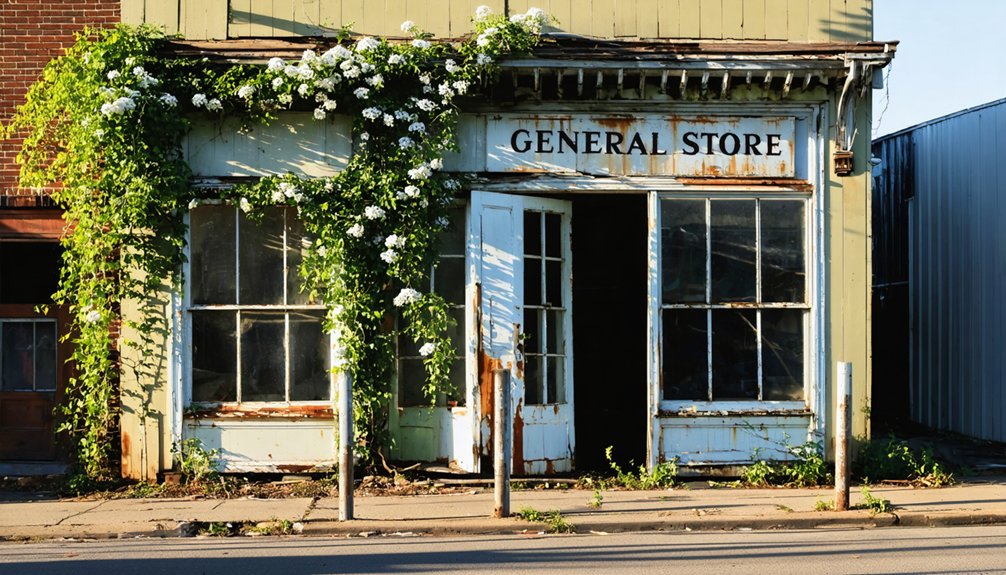
Among Barebone’s most evocative remnants, historical buildings and landmarks offer a glimpse into nineteenth-century Appalachian life.
You’ll find traditional log cabins scattered across the landscape, built with hand-hewn timbers and native stone foundations that reflect the region’s architectural preservation challenges. A one-room schoolhouse, general store ruins, and an abandoned church stand as silent witnesses to the community’s cultural significance.
The town’s cemetery features weathered headstones from its founding era, while an old stone bridge connects to neighboring settlements.
You’ll discover traces of the area’s industrial heritage in sawmill foundations and coal mine entrances. Local historical societies have collected artifacts, though most structures remain in decay, with simple vernacular designs emphasizing function over form through locally sourced materials.
Economic Rise and Decline
You’ll find Barebone’s rise to prosperity began with its strategic position as an inland trading post along essential creek routes, which facilitated robust commerce through river transport and local farming.
The economy later expanded considerably through coal mining operations and lumber industries, with companies like Stearns Coal and Lumber Co. establishing multiple mining communities that employed hundreds of workers.
The town’s decline accelerated in the 1960s when mining operations ceased due to market changes, leading to widespread job losses and eventual abandonment as residents sought opportunities elsewhere.
River Trade Golden Era
Prior to the rise of railroads, the Kentucky River served as a vital economic artery that transformed Barebone into a bustling trade hub in the late 18th and early 19th centuries.
You’d have seen flatboats and keelboats carrying tobacco, hemp, and livestock downstream, while steamboats, first appearing in 1815, revolutionized the speed of commerce.
The river trade’s golden era peaked as Barebone’s merchants capitalized on the bourbon legacy, shipping their whiskey to thriving markets in Louisville, Cincinnati, and New Orleans.
The construction of locks and dams between 1836 and 1842 enabled year-round navigation, though limited vessel sizes to specific dimensions.
As steamboat bartenders stocked Kentucky bourbon to meet growing demand, Barebone’s reputation as a river trade powerhouse continued to flourish until railroad competition emerged.
Mining and Farming Past
Though Barebone’s economy initially centered on subsistence farming and cash crops in its fertile river valleys, the discovery of coal in the early 20th century transformed the town’s fortunes.
You’d have seen early mining techniques evolve as the Bell’s Mine Coal Company expanded operations, drawing migrant workers who boosted the local population. While agricultural practices continued with families maintaining smallholdings for corn and tobacco, farming gradually took a back seat to coal production.
The mining boom brought prosperity through new infrastructure, company housing, and steady payrolls.
But by mid-century, depleted coal seams and mechanization led to Barebone’s decline. Mining’s environmental impact damaged farmland through water pollution and deforestation, while outmigration emptied the town.
Today, only abandoned mine entrances, overgrown railroad beds, and forgotten cemeteries hint at Barebone’s once-thriving past.
Modern Economic Challenges
While many Kentucky towns faced economic challenges in the mid-20th century, Barebone’s decline proved particularly steep due to its heavy reliance on coal mining.
You’ll find the town’s economic troubles amplified after the 2012 coal industry collapse, which devastated local jobs and business activity.
Like other small Kentucky communities, Barebone struggled with transportation shifts as railroad importance diminished and highway systems redirected commerce elsewhere.
The town’s attempts at economic diversification have been hindered by population loss and limited tax revenue, making it difficult to fund new development initiatives.
While some Kentucky towns have successfully leveraged their heritage tourism potential and historic preservation to create new opportunities, Barebone’s isolation and depleted workforce have made such changes especially challenging.
Cultural Heritage and Local Stories
As part of Kentucky’s rich historical tapestry, Barebone’s cultural heritage weaves together personal narratives, folk traditions, and musical influences that have shaped the region’s identity.
Through generations of storytelling, you’ll discover cultural legends that capture the spirit of this once-thriving mining community, while community narratives preserve the authentic voices of those who lived and worked here.
- Local families pass down tales of daily life in the mines, preserving intimate details of Barebone’s industrial past.
- Musical traditions immortalize the town’s history through ballads and folk songs that echo the community’s struggles and triumphs.
- Folklore enthusiasts continue documenting mysterious occurrences and ghostly encounters that add layers of intrigue to Barebone’s legacy.
These stories aren’t just entertainment—they’re essential links to understanding Kentucky’s industrial heritage and the people who built it.
Abandoned Structures and Ghost Town Status
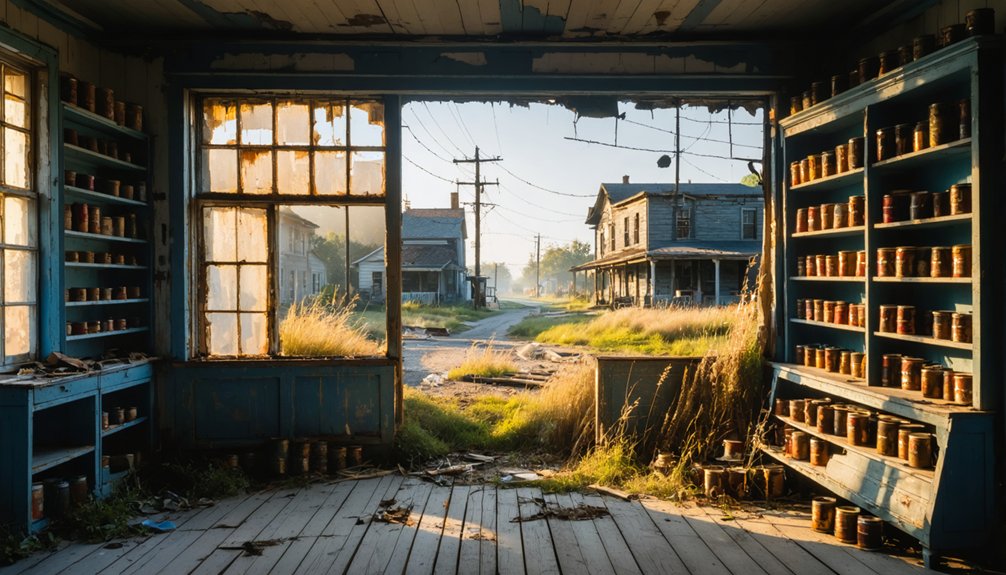
Today, Barebone’s abandoned structures stand as silent witnesses to Kentucky’s bygone industrial era, with deteriorating buildings dating back to the mid-19th century scattered across the landscape.
You’ll find remnants of the Boston Lodge from 1853, its weathered signage still visible among the ruins. The ghost town exploration reveals crumbling architectural features, including precarious second floors and charred wooden beams from past fires.
Nature has reclaimed much of the abandoned architecture, with large trees growing through former lodges and thick brush enveloping old barns.
The town’s desertion stems from economic decline, particularly in mining and transportation sectors. What remains are haunting glimpses of rural Kentucky life: coal tipples, partial staircases, and stone foundations – all testifying to Barebone’s complete transformation from thriving community to genuine ghost town.
Exploring Barebone Today
Due to limited documentation and accessibility challenges, exploring Barebone presents significant obstacles for visitors and researchers alike.
Barebone’s elusive history and hard-to-reach location create unique challenges for those seeking to uncover its forgotten stories.
You’ll need to rely on local myths and ghost stories passed down through generations to piece together the town’s location and history.
Before venturing into Barebone, consider these vital preparation steps:
- Obtain necessary permits and verify legal access, as many areas might be on private property
- Bring specialized navigation equipment, as traditional maps don’t reference this undocumented location
- Connect with local historical societies and residents who might provide essential insights
Your exploration will require careful planning, as the area’s uncertain terrain and lack of marked paths make navigation risky.
Consider documenting any findings to contribute to the preservation of this mysterious Kentucky ghost town’s legacy.
Frequently Asked Questions
Are There Any Reported Ghost Sightings or Paranormal Activities in Barebone?
Unlike Salem’s haunted history, you won’t find documented ghostly encounters in Barebone. While nearby Kentucky ghost towns have their spectral legends, no specific paranormal activities are officially reported here.
What Happened to the Original Residents Who Lived in Barebone?
You’ll find that original inhabitants left due to economic decline when mining jobs disappeared. They relocated to nearby towns and cities, scattering across the region in search of new employment opportunities.
Is It Legal to Visit and Explore Barebone’s Abandoned Structures?
You’ll need to tread carefully – it’s likely illegal to explore these structures without permission. Legal implications include trespassing charges, while exploring ethics demand respect for private property and historical preservation.
Did Any Famous Historical Figures Ever Visit or Live in Barebone?
You won’t find any records of famous visitors or historical events in Barebone. While the area had local families and farmers, no documented evidence shows any historically significant figures ever lived there.
Are There Guided Tours or Organized Visits Available to Barebone?
While 100+ ghost tours operate in Kentucky, you won’t find organized visits to Barebone. You’ll need to explore this remote location independently, as local legends aren’t featured in formal tour circuits.
References
- https://www.nps.gov/biso/learn/historyculture/blueheron.htm
- https://en.wikipedia.org/wiki/Wises_Landing
- https://www.oklahoman.com/story/news/2009/10/28/ghost-town-in-kentucky-has-a-lively-history/61337332007/
- https://www.kentuckytourism.com/things-to-do/outdoors/natural-attractions/big-south-fork/articles/2024/09/12/delightfully-spooky-kentucky
- https://www.youtube.com/watch?v=9SNizgCODHI
- https://wbkr.com/visit-these-20-creepy-kentucky-ghost-towns-for-a-halloween-road-trip/
- https://www.onlyinyourstate.com/experiences/kentucky/urban-legends-ky
- https://www.explore.com/1480108/explore-ghost-towns-scary-road-trip-america-kentucky/
- https://heritage.ky.gov/Documents/Native_History_KyTeachers.pdf
- https://thoughtcatalog.com/seamus-coffey/2015/08/theres-a-town-in-kentucky-that-you-wont-ever-be-able-to-find-on-a-map-and-for-good-reason/
